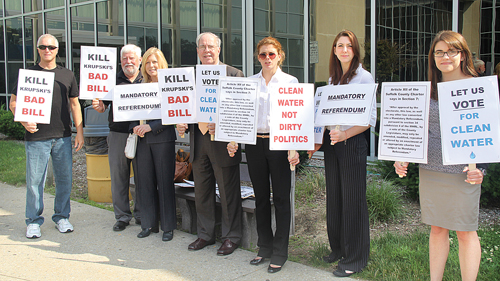Enviros protest farmland preservation bill

Environmental advocates lined up Tuesday to speak out against a bill proposed in the Suffolk County Legislature that’s designed to revise the county’s land preservation program.
The bill, proposed by Legislator Al Krupski (D-Cutchogue), would ensure that half of Drinking Water Protection Program funds, which must be used for land preservation, would be designated for purchasing farmland development rights.
With funding for the program dwindling, the environmental activists believe legislators should focus on securing future land preservation funds “rather than declaring one land type is more superior to all others,” said Kevin McDonald of the Nature Conservancy, during the public hearing portion of Tuesday’s Legislature meeting at the County Center in Riverside.
“We should in fact be arguing for additional funding for a wildly popular program that helps both the environment and the economy,” said Richard Amper, executive director of the Long Island Pine Barrens Society, who also spoke during the hearing.
According to a press release from Mr. Krupski promoting his proposed bill, 95 percent of program funding currently goes to open space purchases, which include wetlands, Pine Barrens, woodlands and hamlet parks. The remaining five percent is allocated for farmland preservation, the release states.
Joe Gergela, director of the Long Island Farm Bureau, said he applauds Mr. Krupski’s efforts in taking on the “sensitive” issue.
“It is a balancing act,” Mr. Gergela said at the hearing. “He has raised awareness of the importance of farmland in the program.”
Since the Drinking Water Protection Program started in 1988, about 12,000 acres of farmland have been preserved, leaving 23,000 acres to be protected, Mr. Gergela said.
Adrienne Esposito of the Citizens Campaign for the Environment also took to the podium. She said that, according to the county charter, the Legislature does not have the last say on changing the voter-approved law, which directs a quarter penny sales tax on every dollar to the Drinking Water Protection Program.
A mandatory referendum is needed to make any amendments to the program, she said.
“You can’t do this legally,” she said.
“When the voters of Suffolk County approved this overwhelmingly important environmental program, they approved very specific wording and provisions and had an expectation that land preservation would proceeded accordingly,” Tom Casey, vice president of the Long Island Greenbelt Trail Conference, told legislators.
The program has secured more than a billion dollars for land preservation throughout the county, Mr. Amper said.
In 2007 the county accelerated the program, bonding purchases against future sales tax revenue through November 2011. But now the county must purchase land on a pay-as-you-go basis, significantly reducing available funds, according to previous Times/Review coverage.
Currently, the county has $25.1 million in program funds to spend on acquisition, but it already has 43 properties, totaling 420 acres, in various stages of purchase, together costing $23.9 million, according to an April 29 press release from Suffolk County executive Steven Bellone.
For future purchases, the county anticipates receiving $5 million from this years sales tax, along with $1.14 million that’s available from leftover program funds. Moving forward, it must rely solely on the yearly sales tax revenue to fund the program, according to the release.
During the hearing, Mr. Amper asked that legislators not lose sight of the program’s goal.
“This is for drinking water protection,” he said. “When you buy open space above important aquifer sources, the water below stays clean.”








